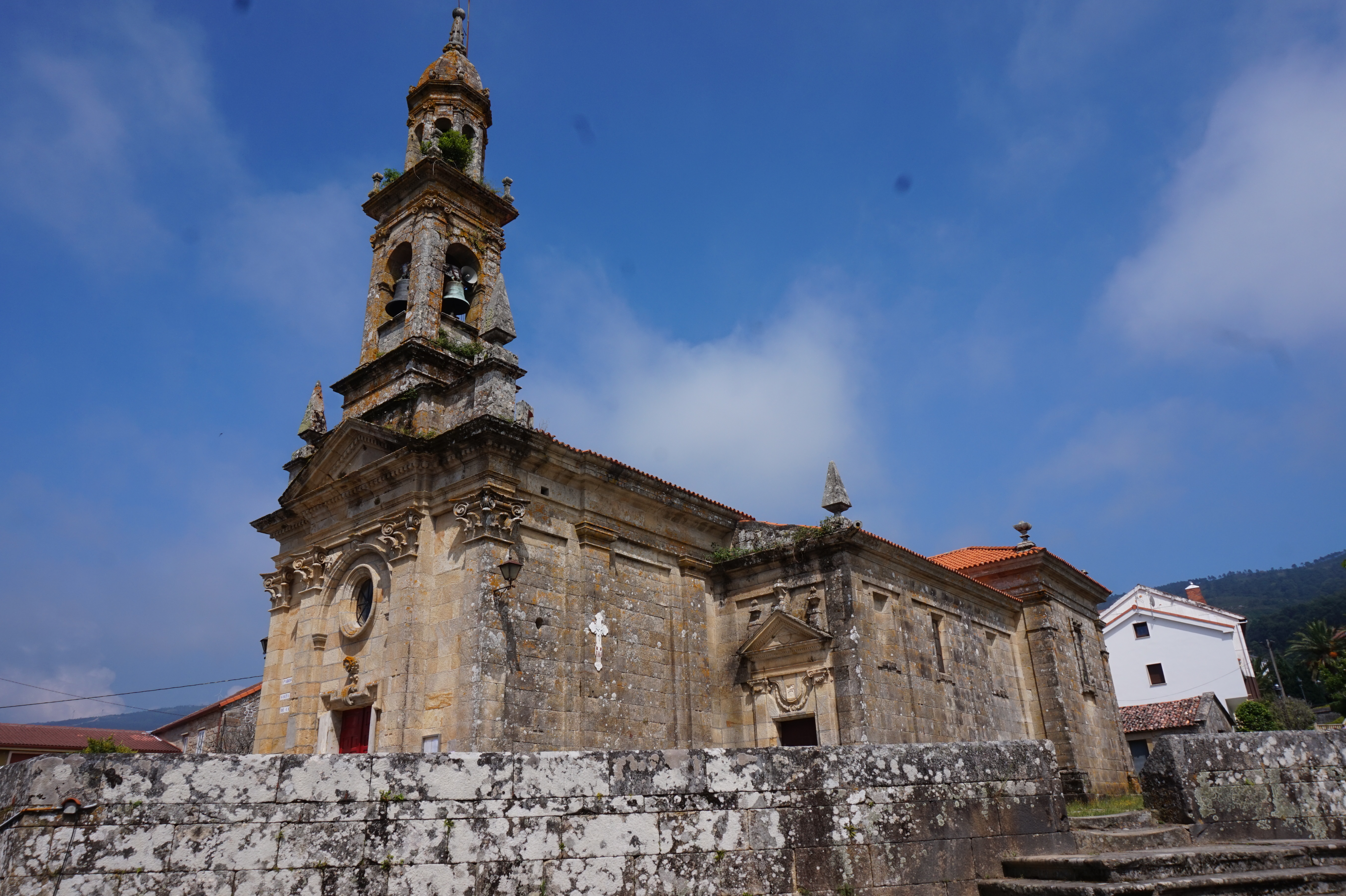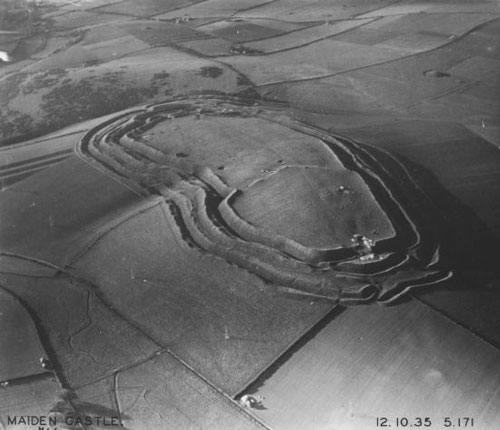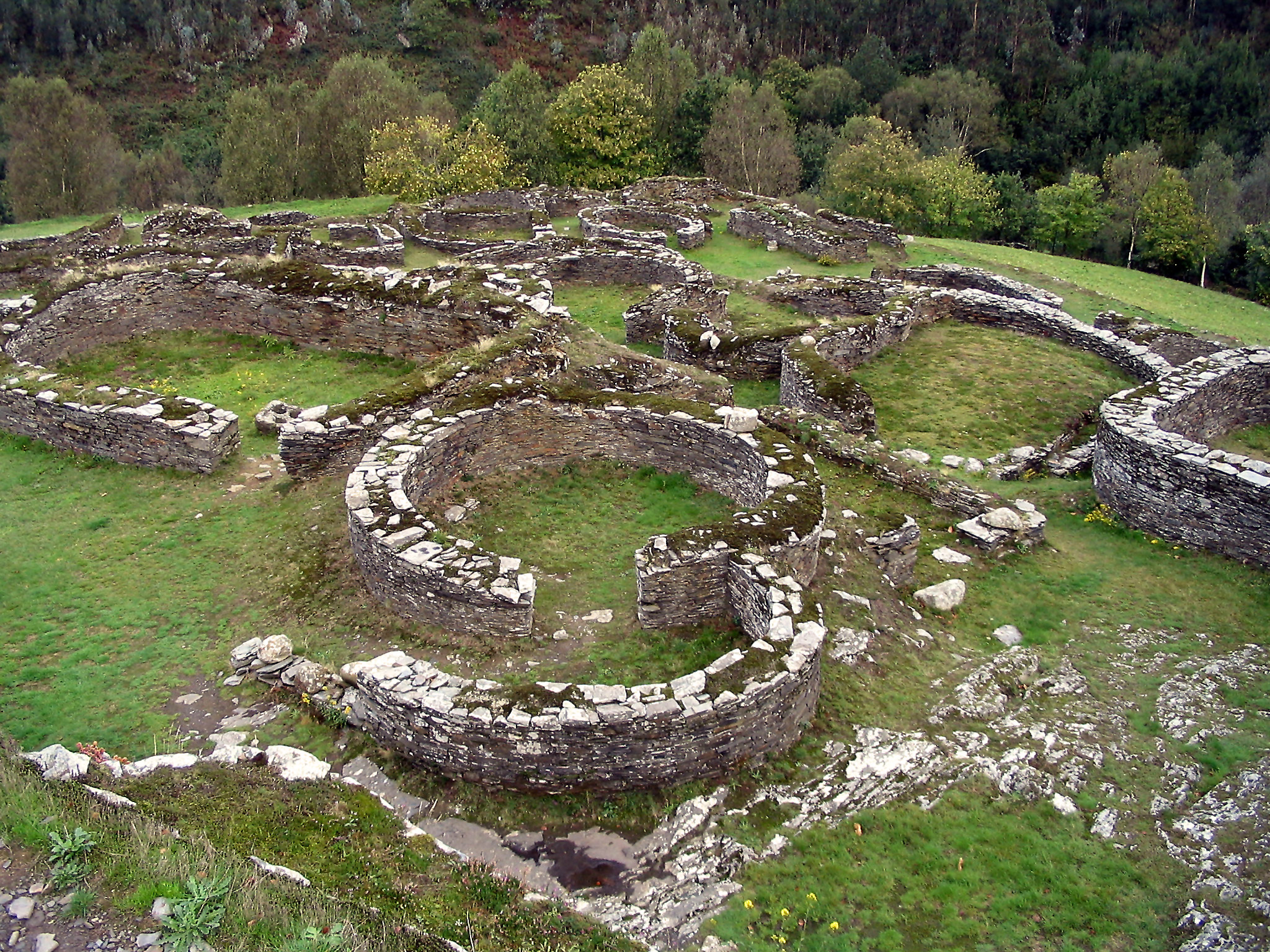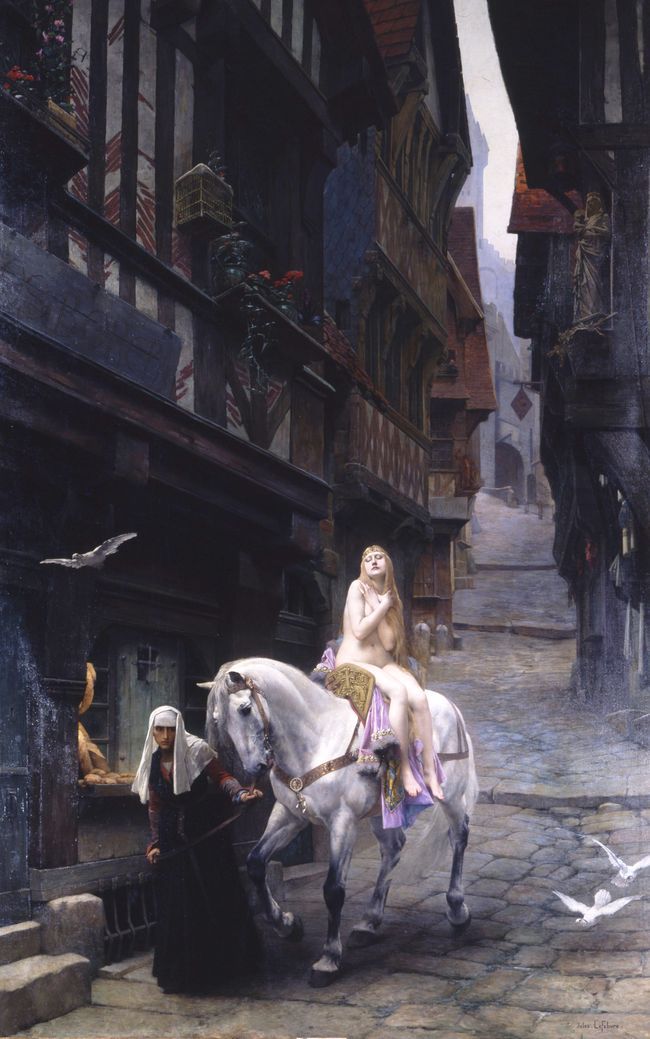|
Castle Of Saint George (Galicia)
The Castle of Saint George was a medieval fortress located in the granite massif of Mount Pindo, in Carnota. History The buildings stood for a good part of the Middle Ages, after being founded (or refounded) in the 10th century (at the time of the Western Towers) by the bishop Sisnando II, as part of his strategy of fortifying the Galician coast against the continuous Norman and Arab attacks and looting from the sea, also defending at this point an important path to Santiago de Compostela, a coveted economic and religious center of the time. That is why it is considered one of the oldest stone castles of Galicia, and of the few that could never have been conquered, that is known. The fortification was located on Pico Pedrullo, a steep cliff high located on the coast of Carnota near the site of , a spectacular natural geological formation with which they melted the walls of the fortress themselves, creating a complex that was very difficult to access. Consisting of several wat ... [...More Info...] [...Related Items...] OR: [Wikipedia] [Google] [Baidu] |
Carnota
Carnota is a municipality of northwestern Spain in the province of A Coruña, autonomous community of Galicia. It belongs to the comarca of Muros. It has an area of 66.4 km2, a population of 5,285 (2004 estimate) and a population density of 79.59 people/km2 It is famous because of its majestic hórreo, granary, the largest one in the world. It has a Barrocan style and is dated back to 1768. Carnota is also very famous for its more than 7 km long beach, the longest in all of Galicia, and Mount Pindo. Its name could come from the pre-Celtic word of "carn", which means stone. Limits The municipality of Carnota borders on the north with the municipality of Dumbría, the northwest with Mazaricos, the west by the Atlantic, and south Muros. It includes various small villages such as O Pindo, Quilmas, A Curra, Panches, Caldebarcos, Vadebois, San Cibran, Vilar de Parada, Fetos, Louredo O viso, Pedrafigueria, Sofan, Mallou, Carballal, Lira, and several more. History ... [...More Info...] [...Related Items...] OR: [Wikipedia] [Google] [Baidu] |
Cabo Corrubedo
Cabo is Spanish, Portuguese and Galician for cape. It may refer to: * Cabo San Lucas, a resort city in Baja California Sur, Mexico * Cabó, a municipality in Alt Urgell, Lleida, Catalonia, Spain Other places * Cabo Blanco, Costa Rica * Cabo Corrientes (municipality), a municipality in Jalisco, Mexico * Cabo Delgado, a province of Mozambique * Cabo Frio, a Brazilian municipality * Cabo Orange National Park, Amapá, Brazil * Cabo Polonio, a hamlet in the Rocha Department, Uruguay * Cabo Rojo, Puerto Rico, a municipality situated on the southwest coast of Puerto Rico * Cabo Verde, the Portuguese name for Cape Verde * San José del Cabo, a city in Baja California Sur, Mexico, part of Los Cabos with Cabo San Lucas Capes: * Cabo Branco Lighthouse, a cape in the extreme est of the entire Americas. Joao Pessoa, Brazil * Cabo Catoche, the northernmost point on the Yucatán Peninsula * Cabo Corrientes, Chocó, a cape on the Pacific coast of Colombia * Cabo Corrientes, Cuba, a cape i ... [...More Info...] [...Related Items...] OR: [Wikipedia] [Google] [Baidu] |
Castro Culture
Castro culture ( gl, cultura castrexa, pt, cultura castreja, ast, cultura castriega, es, cultura castreña, meaning "culture of the hillforts") is the archaeological term for the material culture of the northwestern regions of the Iberian Peninsula (present-day northern Portugal together with the Spanish regions of Galicia, Asturias, and western León) from the end of the Bronze Age (c. 9th century BC) until it was subsumed by Roman culture (c. 1st century BC). It is the culture associated with the Gallaecians and Astures. The most notable characteristics of this culture are: its walled oppida and hillforts, known locally as ''castros'', from Latin ''castrum'' 'castle', and the scarcity of visible burial practices, in spite of the frequent depositions of prestige items and goods, swords and other metallic riches in rocky outcrops, rivers and other aquatic contexts since the Atlantic Bronze Age. This cultural area extended east to the Cares river and south into the lowe ... [...More Info...] [...Related Items...] OR: [Wikipedia] [Google] [Baidu] |
Iron Age Europe
In Europe, the Iron Age is the last stage of the prehistoric period and the first of the protohistoric periods,The Junior Encyclopædia Britannica: A reference library of general knowledge. (1897). Chicago: E.G. Melvin. (seriously? 1897 "Junior" encyclopedia? which initially meant descriptions of a particular area by Greek and Roman writers. For much of Europe, the period came to an abrupt end after conquest by the Romans, though ironworking remained the dominant technology until recent times. Elsewhere, the period lasted until the early centuries AD, and either Christianization or a new conquest in the Migration Period. Iron working was introduced to Europe in the late 11th century BC, probably from the Caucasus, and slowly spread northwards and westwards over the succeeding 500 years. For example, the Iron Age of Prehistoric Ireland begins around 500 BC, when the Greek Iron Age had already ended, and finishes around 400 AD. The use of iron and iron-working technology became ... [...More Info...] [...Related Items...] OR: [Wikipedia] [Google] [Baidu] |
List Of Castros In Galicia
This is a list of castros in Galicia (Spain), ordered by provinces. Province of A Coruña Province of Lugo Province of Ourense Province of Pontevedra See also * List of castros in Asturias * List of castros in Cantabria * List of castros in Castile and León * List of castros in the Basque country * Castro culture * Castros in Spain External links Castros catalog in Ferrol, Narón and Valdoviño. {{DEFAULTSORT:Castros in Galicia Galicia Galicia may refer to: Geographic regions * Galicia (Spain), a region and autonomous community of northwestern Spain ** Gallaecia, a Roman province ** The post-Roman Kingdom of the Suebi, also called the Kingdom of Gallaecia ** The medieval King ... Galicia (Spain) Lists of buildings and structures in Spain * Buildings and structures in Galicia (Spain) Hill forts in Spain Tourist attractions in Galicia (Spain) ... [...More Info...] [...Related Items...] OR: [Wikipedia] [Google] [Baidu] |
Castros (Spain)
A castro is a fortified settlement, usually pre-Roman, some from late Bronze Age and Iron Age, the oldest research associated with the Celtic culture. These are frequently found in the Northern Spain, particularly in Asturias, Galicia, Cantabria, Basque Country and the province of Ávila, with the Castro culture and on the plateau with Las Cogotas culture. The word ''castro'' comes from the Latin ''castrum'', which means "hill fort". Castros of the Castro culture The castro is a fortified village that began to be inhabited from the 6th century BC, lacking streets of right angles and full of construction almost always circular. The oldest houses were mostly of straw-mud and the latest masonry. The roof was made of branches and mud and after long poles. Basically, they were unique rooms. These are located in naturally protected areas (heights, riots rivers, small peninsulas), close to water sources and arable land and on the border between these and higher areas of grazing. ... [...More Info...] [...Related Items...] OR: [Wikipedia] [Google] [Baidu] |
Queen Lupa
Queen Lupa (also known as Raíña Lupa, Raíña Lopa, Raíña Luparia, Raíña Luca and Raíña Loba) is a character from Galician mythology. She is mentioned in both the ''Codex Calixtinus'' and the ''Golden Legend'' involving the translation of the body of the Apostle James by his disciples. Her name alludes to her cunning, and she is written as being a roadblock to the disciples of the Apostle James, Theodore and Athanasius, as they search for a place to entomb his body. She eventually sees her error and converts to Christianity. Her story is well-known throughout Galicia and she still influences the culture of that portion of Spain. Her story is integral to the translation of the relics of the apostle, and her home is along the route of the Portuguese Way to Santiago de Compostela. Legend Galician mythology, Galician tradition holds that Lupa, a widowed noblewoman, lived in Castro Lupario, along what is now called the Portuguese Way. She appears in Book III (''Liber de tr ... [...More Info...] [...Related Items...] OR: [Wikipedia] [Google] [Baidu] |
Oral Tradition
Oral tradition, or oral lore, is a form of human communication wherein knowledge, art, ideas and cultural material is received, preserved, and transmitted orally from one generation to another. Vansina, Jan: ''Oral Tradition as History'' (1985), reported statements from present generation which "specifies that the message must be oral statements spoken, sung or called out on musical instruments only"; "There must be transmission by word of mouth over at least a generation". He points out, "Our definition is a working definition for the use of historians. Sociologists, linguists or scholars of the verbal arts propose their own, which in, e.g., sociology, stresses common knowledge. In linguistics, features that distinguish the language from common dialogue (linguists), and in the verbal arts features of form and content that define art (folklorists)."Ki-Zerbo, Joseph: "Methodology and African Prehistory", 1990, ''UNESCO International Scientific Committee for the Drafting of a Gene ... [...More Info...] [...Related Items...] OR: [Wikipedia] [Google] [Baidu] |
Legend
A legend is a genre of folklore that consists of a narrative featuring human actions, believed or perceived, both by teller and listeners, to have taken place in human history. Narratives in this genre may demonstrate human values, and possess certain qualities that give the tale verisimilitude. Legend, for its active and passive participants may include miracles. Legends may be transformed over time to keep them fresh and vital. Many legends operate within the realm of uncertainty, never being entirely believed by the participants, but also never being resolutely doubted. Legends are sometimes distinguished from myth Myth is a folklore genre consisting of Narrative, narratives that play a fundamental role in a society, such as foundational tales or Origin myth, origin myths. Since "myth" is widely used to imply that a story is not Objectivity (philosophy), ...s in that they concern human beings as the main characters rather than gods, and sometimes in that they have s ... [...More Info...] [...Related Items...] OR: [Wikipedia] [Google] [Baidu] |
Irmandiño Revolts
The Irmandiño revolts (or Irmandiño Wars) were two revolts that took place in the 15th-century Kingdom of Galicia against attempts by the regional nobility to maintain their rights over the peasantry and bourgeoisie. The revolts were also part of the larger phenomenon of popular revolts in late medieval Europe caused by the general economic and demographic crises in Europe during the 14th and 15th centuries. Similar rebellions broke out in the Hispanic Kingdoms, including the War of the Remences in Catalonia and the ''foráneo'' revolts in the Balearic Islands. Background Despite being joined to the Crown of Castile with the dynastic union of the Kingdoms of León and Castile in 1037, the Kingdom of Galicia maintained unique features, characterized by an economy which depended heavily on agriculture and a society marked by enormous feudal power that was concentrated in both secular and ecclesiastical lords. In addition, Galicia was isolated from the rest of the kingdom due ... [...More Info...] [...Related Items...] OR: [Wikipedia] [Google] [Baidu] |
Peñafiel Castle
Peñafiel Castle is located in Peñafiel, Valladolid Province, Spain. The castle is more than long and encloses an area about wide. Standing in the middle is a high three storey keep. Fernan Gonzalez began construction on the Peñafiel site in 947, as a frontier outpost in defense against the Arabs. A castle was built in 1013 by Sancho Garcia to protect the land. Several other members of the Spanish nobility added to the castle including Juan Manuel and Pedro Girón. Blanche I, Queen of Navarre gave birth to the Charles, Prince of Viana in the keep of Peñafiel in 1421. Gallery Image:CastilloPeñafiel2.jpg, Image:Castillo de Penafiel 7111.JPG, Image:CastilloPeñafiel4.jpg, Image:Peñafiel - Plaza del coso - 20110210a.jpg, View from Plaza del Coso Image:Castillo Peñafiel.jpg, Image:Castillo de Peñafiel (Valladolid). Torre del Homenaje.jpg, Image:Peñafiel - Castillo 08.JPG, Image:Peñafiel PM 17927.jpg, Image:Penafiel-Espana0011.JPG, Image:Castillo de Peñafi ... [...More Info...] [...Related Items...] OR: [Wikipedia] [Google] [Baidu] |
Lope Sánchez De Ulloa
Lope is an old given name of Basque, Gascon and Spanish origin, derived from Latin ''lupus'', meaning "wolf". Lope may refer to: *Lope de Isásaga (1493–1515), Basque Spanish ''conquistador'' *Lope de Aguirre (1510s – 1561), Basque Spanish ''conquistador'' *Lope de Vega (1562–1635), Spanish poet * Lope Martín, Spanish sailor *Lope Recio Loynaz (1860-1927), Cuban general * Lupo II of Gascony (died 778) * ''Lope'' (film), a 2010 film *Lope de Vega (horse), an Irish bred Thoroughbred racehorse *Lope language, a Loloish language of China * Lopé Department, Gabon * Lope, a type of canter and gallop in horseback riding See also * Lop (other) * Lõpe (other) * López * Loping Airfield, a World War II United States Army Air Forces airfield China * Luoping County Luoping County () is located in Qujing City, in eastern Yunnan province, China, bordering Guizhou province to the east and the Guangxi Zhuang Autonomous Region to the southeast. The county of Luoping ... [...More Info...] [...Related Items...] OR: [Wikipedia] [Google] [Baidu] |






